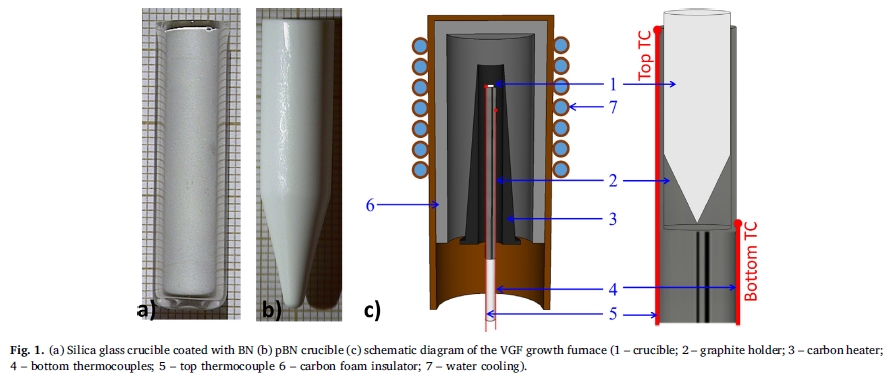Ushering in a New Era of High-Performance Semiconductors: French Research Team Breaks Through CrSi2 Single Crystal Growth Technique
A recent study on high-performance semiconductor materials has sparked widespread attention in the scientific community. Researchers A. Molla, S. Laborde, F. Baroub, and M. Beaudhuin from the University of Montpellier (Univ Montpellier) and the National Center for Scientific Research (CNRS) in France have published their latest findings in the Journal of Crystal Growth. They successfully grew centimeter-scale single crystals of CrSi2 (chromium disilicide) using the vertical gradient freezing (VGF) method, a breakthrough that promises potential advancements in optoelectronic devices, thin-film resistors, and thermoelectric applications.
The Birth of High-Quality Crystals
The research team used two different types of crucibles - silica (SiO2) crucibles and crucibles coated with boron nitride (BN) or pyrolytic boron nitride (pBN) - to minimize adhesion and reaction with the molten Cr-Si alloy. The results showed that using pBN crucibles under a thermal gradient of 0.6 K/mm and a growth rate of 10 mm/h produced high-quality CrSi2 single crystals with a mosaic spread of 1-2 degrees.

The Choice of pBN Crucibles
The selection of pBN crucibles was not accidental. Pyrolytic boron nitride is a high-purity ceramic material widely used in high-temperature crystal growth due to its stability at high temperatures, chemical inertness, and excellent thermal conductivity. Its smooth surface and low reactivity with most molten metals help reduce defects during the crystal growth process, ensuring high purity and consistency of the final product.
In this study, the researchers specifically highlighted the importance of the surface characteristics of pBN crucibles for the successful growth of CrSi2 single crystals. After treating the pBN crucibles with hydrofluoric acid (HF), the change in the surface chemistry affected the wettability and roughness of the melt, which in turn influenced the quality of the crystals. This finding emphasizes the crucial role of crucible selection in the growth of high-quality crystals.
It is worth mentioning that QSAM Inc., a leading manufacturer of PBN crucibles in the market, provides high-quality services to research users. Their expertise in manufacturing and customization capabilities allow researchers to obtain the most suitable high-quality crucibles for their specific experimental needs, supporting the advancement of scientific research.

The New Star of Semiconductor Materials
CrSi2, a semiconductor transition metal silicide, is highly sought after for its high thermal stability and relatively small indirect bandgap. It has shown great potential in optoelectronic devices, thin-film resistors, and thermoelectric applications. The successful growth of CrSi2 single crystals in this study brings new hope for these application areas.
Meticulous Exploration of the Microscopic
World
The research team also conducted a detailed analysis of the microstructure of
the polycrystalline samples. Through texture analysis techniques, they found
that the growth conditions significantly influence the microstructure,
providing important clues for optimizing the microstructure for large-scale
applications.
The Secrets of Crystal Growth
CrSi2 has a specific crystal structure in the hexagonal C40 structure with the P6222 space group and associated lattice parameters. Previously, the growth of large single crystals mainly relied on the Czochralski method and the zone melting method, while smaller single crystals were obtained using the tin-flux Bridgman technique. However, there have been few reports on the growth mechanism of CrSi2 alloys using the VGF method. The success of this research provides valuable data for understanding the application of this method in the growth of CrSi2 alloys.
Conclusion and Future Outlook
The study has drawn positive conclusions by growing CrSi2 single crystals in new pBN crucibles at a growth rate of 10 mm/h and a thermal gradient of 0.6 K/mm. This approach not only has the potential to improve the production process but also contributes to the development of CrSi2 materials for various technological applications. Further research is needed to optimize the microstructure to expand its industrial applications.
Epilogue
This research is not just a scientific achievement; it also heralds the dawn of a new era in materials science. In the future, we can expect breakthrough applications of CrSi2 materials in optoelectronics, energy conversion, and beyond, contributing to the development of human society. In this process, companies like QSAM Inc. will continue to play a crucial role by providing high-quality pBN crucibles to support the progress of scientific research. As materials science advances, the future technological revolution is quietly unfolding.
